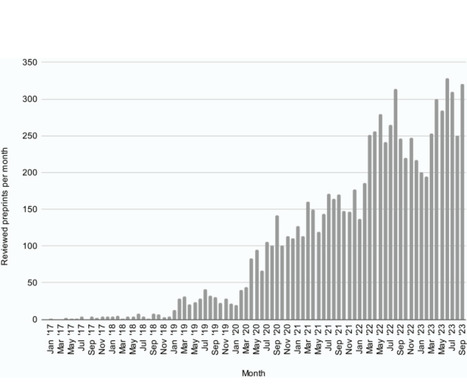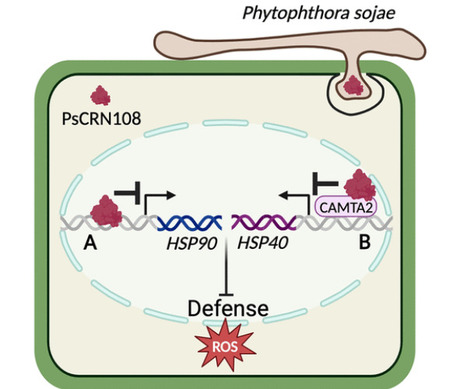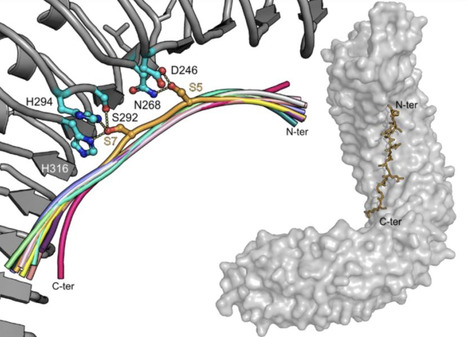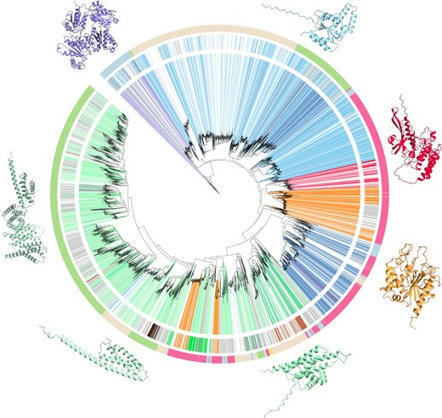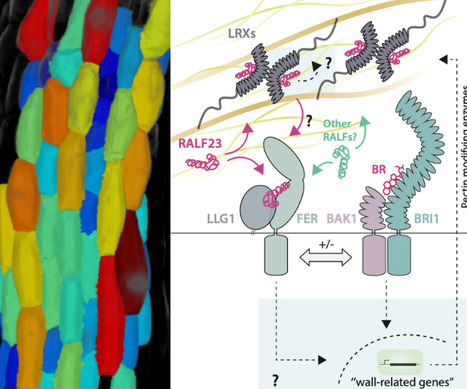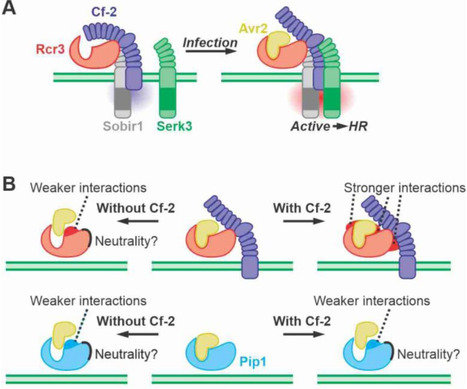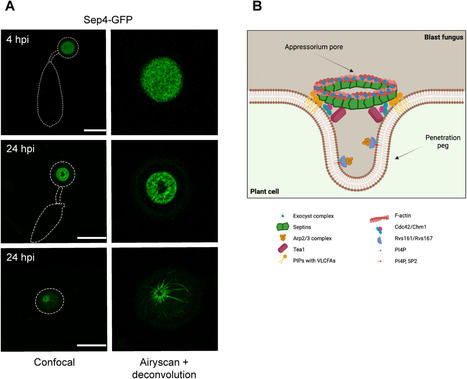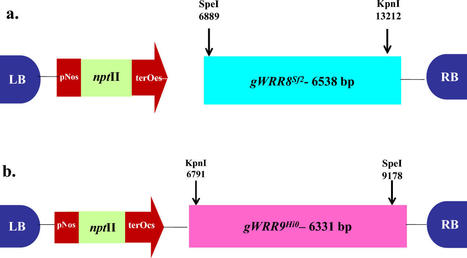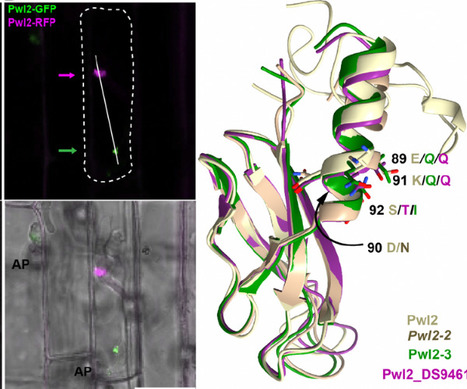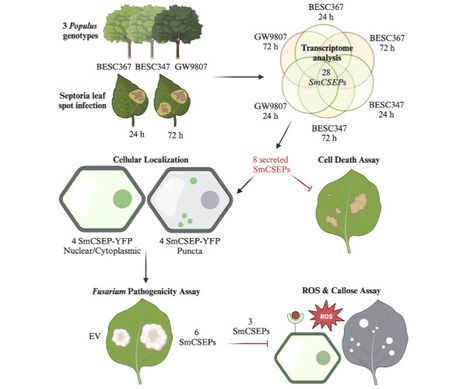 Your new post is loading...
 Your new post is loading...
Transmembrane signaling by plant receptor kinases (RKs) has long been thought to involve reciprocal trans-phosphorylation of their intracellular kinase domains. The fact that many of these are pseudokinase domains, however, suggests that additional mechanisms must govern RK signaling activation. Non-catalytic signaling mechanisms of protein kinase domainshave been described in metazoans, but information is scarce for plants. Recently, a non-catalytic function was reported for the leucine-rich repeat (LRR)-RK subfamily XIIa member EFR (ELONGATION FACTOR TU RECEPTOR) and phosphorylation-dependent conformational changes were proposed to regulate signaling of RKs with non-RD kinase domains. Here, using EFR as a model, we describe a non-catalytic activation mechanism for LRR-RKs with non-RD kinase domains. EFR is an active kinase, but a kinase-dead variant retains the ability to enhance catalytic activity of its co-receptor kinase BAK1/SERK3 (BRASSINOSTEROID INSENSITIVE 1-ASSOCIATED KINASE 1/SOMATIC EMBRYOGENESIS RECEPTOR KINASE 3). Applying hydrogen-deuterium exchange mass spectrometry (HDX-MS) analysis and designing homology-based intragenic suppressor mutations, we provide evidence that the EFR kinase domain must adopt its active conformation in order to activate BAK1 allosterically, likely by supporting αC-helix positioning in BAK1. Our results suggest a conformational toggle model for signaling, in which BAK1 first phosphorylates EFR in the activation loop to stabilize its active conformation, allowing EFR in turn to allosterically activate BAK1.
FULL TEXT https://apsjournals.apsnet.org/doi/10.1094/PBIOMES-12-23-0132-R Chitin amendment of peat substrate has been proven effective in promoting lettuce growth and increasing phenolic compounds in lettuce seedlings. However, the effect of chitin soil amendment on lettuce growth in mineral soil remains unexplored. The effect of chitin amendment of mineral soil on lettuce growth and metabolite changes was investigated for the first time in the present study in comparison to chitin amended peat substrate. Our findings showed that chitin addition in peat substrate increased lettuce head weight by approximately 50% at harvest, whereas this increase was 30% when added to mineral soil. Targeted metabolomics analysis indicated that chitin addition affected the phenolic compounds in lettuce seedlings, but this effect varied between soil types. Moreover, untargeted metabolomics analysis suggested that using peat substrate or mineral soil had a greater influence on produced lettuce metabolites than chitin addition. Rhizobiome analysis showed that specifically Mortierellaceae family members, known for chitin degradation and plant growth promotion, significantly increased in peat substrate upon chitin treatment. In mineral soil, three bacterial genera and five fungi, including known plant growth promoting genera, were significantly more abundant upon chitin treatment but not Mortierellaceae. We assume that the observed effects primarily stem from soil physiochemical characteristics and from chitin induced alterations in rhizobiome composition, particularly the presence of Mortierellaceae members, leading to promoted lettuce growth. Despite the variability, chitin remains an environmentally friendly alternative to synthetic fertilizers in lettuce production, but its beneficial effects are dependent on rhizobiome composition, which should be considered before chitin application.
Pathogens have evolved sophisticated mechanisms to manipulate host cell membrane dynamics, a crucial adaptation to survive in hostile environments shaped by innate immune responses. Plant- derived membrane interfaces, engulfing invasive hyphal projections of fungal and oomycete pathogens, are prominent junctures dictating infection outcomes. Understanding how pathogens transform these host-pathogen interfaces to their advantage remains a key biological question. Here, we identified a conserved effector, secreted by plant pathogenic oomycetes, that co-opts a host Rab GTPase-activating protein (RabGAP), TBC1D15L, to remodel the host-pathogen interface. The effector, PiE354, hijacks TBC1D15L as a susceptibility factor to usurp its GAP activity on Rab8a—a key Rab GTPase crucial for defense-related secretion. By hijacking TBC1D15L, PiE354 purges Rab8a from the plasma membrane, diverting Rab8a-mediated immune trafficking away from the pathogen interface. This mechanism signifies an uncanny evolutionary adaptation of a pathogen effector in co- opting a host regulatory component to subvert defense-related secretion, thereby providing unprecedented mechanistic insights into the reprogramming of host membrane dynamics by pathogens.
Cell-surface receptors form the front line of plant immunity. The leucine-rich repeat (LRR)-receptor-like kinases SOBIR1 and BAK1 are required for the functionality of the tomato LRR-receptor-like protein Cf-4, which detects the secreted effector Avr4 of the pathogenic fungus Fulvia fulva. Here, we show that the kinase domains of SOBIR1 and BAK1 directly phosphorylate each other and that residues Thr522 and Tyr469 of the kinase domain of Nicotiana benthamiana SOBIR1 are required for its kinase activity and for interacting with signalling partners, respectively. By knocking out multiple genes belonging to different receptor-like cytoplasmic kinase (RLCK)-VII subfamilies in N. benthamiana:Cf-4, we show that members of RLCK-VII-6, −7, and −8 differentially regulate the Avr4/Cf-4-triggered biphasic burst of reactive oxygen species. In addition, members of RLCK-VII-7 play an essential role in resistance against the oomycete pathogen Phytophthora palmivora. Our study provides molecular evidence for the specific roles of RLCKs downstream of SOBIR1/BAK1-containing immune complexes. Cell-surface receptors form the front line of plant immunity. Here, the authors show that the RLP co-receptors SOBIR1 and BAK1 directly phosphorylate each other, leading to activation of the immune receptor complex in which RLCKs are differentially required for production of reactive oxygen species that play a role in resistance against Phytophthora palmivora.
Dynamic host–pathogen interactions determine whether disease will occur. Pathogen effector proteins are central players in such disease development. On one hand, they improve susceptibility by manipulating host targets; on the other hand, they can trigger immunity after recognition by host immune receptors. A major research direction in the study of molecular plant pathology is to understand effector-host interactions, which has informed the development and breeding of crops with enhanced disease resistance. Recent breakthroughs on experiment- and artificial intelligence-based structure analyses significantly accelerate the development of this research area. Importantly, the detailed molecular insight of effector–host interactions enables precise engineering to mitigate disease. Here, we highlight a recent study by Xiao et al., who describe the structure of an effector-receptor complex that consists of a fungal effector, with polygalacturonase (PG) activity, and a plant-derived polygalacturonase-inhibiting protein (PGIP). PGs weaken the plant cell wall and produce immune-suppressive oligogalacturonides (OGs) as a virulence mechanism; however, PGIPs directly bind to PGs and alter their enzymatic activity. When in a complex with PGIPs, PGs produce OG polymers with longer chains that can trigger immunity. Xiao et al. demonstrate that a PGIP creates a new active site tunnel, together with a PG, which favors the production of long-chain OGs. In this way, the PGIP essentially acts as both a PG receptor and enzymatic manipulator, converting virulence to defense activation. Taking a step forward, the authors used the PG-PGIP complex structure as a guide to generate PGIP variants with enhanced long-chain OG production, likely enabling further improved disease resistance. This study discovered a novel mechanism by which a plant receptor plays a dual role to activate immunity. It also demonstrates how fundamental knowledge, obtained through structural analyses, can be employed to guide the design of proteins with desired functions in agriculture.
Crop production often faces challenges from plant diseases, and biological control emerges as an effective, environmentally friendly, cost-effective, and sustainable alternative to chemical control. Wheat blast disease caused by fungal pathogen Magnaporthe oryzae Triticum (MoT), is a potential catastrophic threat to global food security. This study aimed to identify potential bacterial isolates from rice and wheat seeds with inhibitory effects against MoT. In dual culture and seedling assays, three bacterial isolates (BTS-3, BTS-4, and BTLK6A) demonstrated effective suppression of MoT growth and reduced wheat blast severity when artificially inoculated at the seedling stage. Genome phylogeny identified these isolates as Bacillus subtilis (BTS-3) and B. velezensis (BTS-4 and BTLK6A). Whole-genome analysis revealed the presence of genes responsible for controlling MoT through antimicrobial defense, antioxidant defense, cell wall degradation, and induced systemic resistance (ISR). Taken together, our results suggest that the suppression of wheat blast disease by seed endophytic B. subtilis (BTS-3) and B. velezensis (BTS-4 and BTLK6A) is liked with antibiosis and induced systemic resistance to wheat plants. A further field validation is needed before recommending these endophytic bacteria for biological control of wheat blast.
Crop disease pandemics are often driven by clonal lineages of plant pathogens that reproduce asexually. How these clonal pathogens continuously adapt to their hosts despite harboring limited genetic variation, and in absence of sexual recombination remains elusive. Here, we reveal multiple instances of horizontal chromosome transfer within pandemic clonal lineages of the blast fungus Magnaporthe (Syn. Pyricularia) oryzae. We identified a horizontally transferred 1.2Mb supernumerary mini-chromosome which is remarkably conserved between M. oryzae isolates from both the rice blast fungus lineage and the lineage infecting Indian goosegrass (Eleusine indica), a wild grass that often grows in the proximity of cultivated cereal crops. Furthermore, we show that this mini-chromosome was horizontally acquired by clonal rice blast isolates through at least nine distinct transfer events over the past three centuries. These findings establish horizontal mini-chromosome transfer as a mechanism facilitating genetic exchange among different host-associated blast fungus lineages. We propose that blast fungus populations infecting wild grasses act as genetic reservoirs that drive genome evolution of pandemic clonal lineages that afflict cereal crops.
As preprints become more widely used and accepted, they raise the possibility of rethinking the peer-review process. This Consensus View issues a call to action to accelerate the growing momentum of preprint sharing and provides recommendations to empower researchers to provide open and constructive peer review for preprints.
COMMENTARY: The oomycete pathogen, Phytophthora, secretes both apoplastic and cytoplasmic effectors into its plant host upon infection. CRNs (crinkling and necrosis proteins) are a major family of effector proteins characterized by their variable C-terminal domains and conserved N-terminal motifs (Schornack et al. 2010). Although many CRN effectors have been predicted across various oomycete and fungal pathogens, the mechanisms of action of only a few have been characterized.
Nicotiana benthamiana is increasingly gaining prominence as a model plant species with recently published high-quality genome assemblies, which will further enable forward and reverse genetic approaches (Bally et al., 2018; Derevnina et al., 2019; Kourelis et al., 2019; Ranawaka et al., 2023; Vollheyde et al., 2023). However, the generation time of N. benthamiana poses a bottleneck in the creation of mutant and transgenic plant lines. Speed breeding (SB), by extended photoperiods and adjustments to growth parameters, is an efficient way to reduce generation times for many crop and model plant species (Ghosh et al., 2018; Watson et al., 2018; Hickey et al., 2019; Varshney et al., 2021). We hypothesized that an extended photoperiod could reduce the seed to seed generation time of N. benthamiana. We tested this hypothesis by comparing generation times under SB conditions to traditionally used photoperiods in growth chambers and green house settings. We found that a 22h photoperiod reduced the generation time of N. benthamiana by approximately 2 weeks (16-22%). Fertilization in combination with a far-red light spectrum did not yield a further reduction in generation time when combined with SB conditions. Our findings further contribute to the establishment of N. benthamiana as an important model organism for plant research.
Secreted signaling peptides are central regulators of growth, development, and stress responses, but specific steps in the evolution of these peptides and their receptors are not well understood. In addition, the molecular mechanisms of peptide-receptor binding are only known for a few examples, primarily owing to the limited availability of structural capabilities to few laboratories worldwide. Plants have evolved a multitude of secreted signaling peptides and corresponding transmembrane receptors. Stress-responsive SERINE RICH ENDOGENOUS PEPTIDES (SCOOPs) were recently identified. Bioactive SCOOPs are proteolytically processed by subtilases and are perceived by the leucine-rich repeat receptor kinase MALE DISCOVERER 1-INTERACTING RECEPTOR-LIKE KINASE 2 (MIK2) in the model plant Arabidopsis thaliana. How SCOOPs and MIK2 have (co-)evolved, and how SCOOPs bind to MIK2 are however still unknown. Using in silico analysis of 350 plant genomes and subsequent functional testing, we revealed the conservation of MIK2 as SCOOP receptor within the plant order Brassicales. We then leveraged AlphaFold-Multimer and comparative genomics to identify two conserved putative SCOOP-MIK2 binding pockets across Brassicales MIK2 homologues predicted to interact with the ‘SxS’ motif of otherwise sequence-divergent SCOOPs. Notably, mutagenesis of both predicted binding pockets compromised SCOOP binding to MIK2, SCOOP-induced complex formation between MIK2 and its co-receptor BRASSINOSTEROID INSENSITIVE 1-ASSOCIATED KINASE 1 (BAK1), and SCOOP-induced reactive oxygen species production; thus, confirming our in silico predictions. Collectively, in addition to revealing the elusive SCOOP-MIK2 binding mechanisms, our analytic pipeline combining phylogenomics, AI-based structural predictions, and experimental biochemical and physiological validation provides a blueprint for the elucidation of peptide ligand-receptor perception mechanisms.
To reduce the application dosage of thiamethoxam (TMX), we investigated the deposition and dissipation patterns in a pepper-planted ecosystem under different planting modes across four regions in China, namely Hainan (HN), Zhejiang (ZJ), Anhui (AH) and Hebei (HB). This study focused on the deposition and dissipation of TMX at concentrations of 63.00, 47.25, 31.50, 23.63 and 15.75 g a.i.hm-2. As the application dose increased, the deposition amount of TMX initially increased in the plants and cultivated soil, showing obvious geographic differences in four cultivation areas. Surprisingly, the initial amount of TMX deposited the pepper-cultivated greenhouse of ZJ and AH was 1.1–2.1-fold and 1.0–3.6-fold higher than that in the open field system at the same application dose, respectively. In pepper leaves, stems, fruits and soil, the dissipation exhibited rapid growth and then slowed. However, the residual concentration showed an increasing trend, followed by a subsequent decrease in the pepper roots. In different planting regions, the dissipation rate of TMX followed the order HN > ZJ > AH > HB in pepper plants and cultivated soil. In comparison to the open field, the total TMX retention rate in greenhouse was higher, indicating overall greater persistence in the greenhouse conditions. These findings reveal the deposition and dissipation characteristics of TMX within the pepper-field ecosystem, offering a significant contribution to the risk assessment of pesticides.
|
Bacteria-derived lipopeptides are immunogenic triggers of host defenses in metazoans and plants. Root-associated rhizobacteria produce cyclic lipopeptides that activate systemically induced resistance (IR) against microbial infection in various plants. How these molecules are perceived by plant cells remains elusive. Here, we reveal that immunity activation in Arabidopsis thaliana by the lipopeptide elicitor surfactin is mediated by docking into specific sphingolipid-enriched domains and relies on host membrane deformation and subsequent activation of mechanosensitive ion channels. This mechanism leads to host defense potentiation and resistance to the necrotroph B. cinerea but is distinct from host pattern recognition receptor-mediated immune activation and reminiscent of damage-induced plant immunity.
Carbohydrate-based cell wall signaling impacts plant growth, development, and stress responses; however, how cell wall signals are perceived and transduced remains poorly understood. Several cell wall breakdown products have been described as typical damage-associated molecular patterns (DAMPs) that activate plant immunity, including pectin-derived oligogalacturonides (OGs). Receptor kinases (RKs) of the WALL-ASSOCIATED KINASE (WAK) family have been shown to bind pectin and OGs, and were previously proposed as OG receptors. However, unambiguous genetic evidence for the role of WAKs in OG responses is lacking. Here, we investigated the role of Arabidopsis WAKs in OG perception using a novel deletion mutant of the clustered WAK family. Using a combination of immune assays for early and late pattern-triggered immunity (PTI), we show that WAKs are dispensable for OG-induced signaling and immunity, indicating that they are not bona fide OG receptors.
COMMENTARY It is important for bacterial pathogens to precisely detect diverse environmental cues and merge these signals to generate a coordinated response that sustains growth and establishes virulence. This is carried out by multiple receptor proteins on the membrane, small molecules that respond to changes in receptor status, and transcription factors that bind these small molecules and regulate the expression of specific genes. It is essential to understand how this complex orchestration of events happens at the molecular level, in order to gain mechanistic insights into the survival and virulence of these pathogens.
- Arabidopsis Col-0 RPP2A and RPP2B confer recognition of Arabidopsis downy mildew (Hyaloperonospora arabidopsidis [Hpa]) isolate Cala2, but the identity of the recognized ATR2Cala2 effector was unknown.
- To reveal ATR2Cala2, an F2 population was generated from a cross between Hpa-Cala2 and Hpa-Noks1. We identified ATR2Cala2 as a non-canonical RxLR-type effector that carries a signal peptide, a dEER motif, and WY domains but no RxLR motif. Recognition of ATR2Cala2 and its effector function were verified by biolistic bombardment, ectopic expression and Hpa infection.
- ATR2Cala2 is recognized in accession Col-0 but not in Ler-0 in which RPP2A and RPP2B are absent. In ATR2Emoy2 and ATR2Noks1 alleles, a frameshift results in an early stop codon. RPP2A and RPP2B are essential for the recognition of ATR2Cala2. Stable and transient expression of ATR2Cala2 under 35S promoter in Arabidopsis and Nicotiana benthamiana enhances disease susceptibility.
- Two additional Col-0 TIR-NLR (TNL) genes (RPP2C and RPP2D) adjacent to RPP2A and RPP2B are quantitatively required for full resistance to Hpa-Cala2. We compared RPP2 haplotypes in multiple Arabidopsis accessions and showed that all four genes are present in all ATR2Cala2-recognizing accessions.
- Nucleotide-binding domain and leucine-rich repeat (NLR) proteins with pathogen sensor activities have evolved to initiate immune signaling by activating helper NLRs. However, the mechanisms underpinning helper NLR activation by sensor NLRs remain poorly understood. Although coiled coil (CC) type sensor NLRs such as the Potato virus X disease resistance protein Rx have been shown to activate the oligomerization of their downstream helpers NRC2, NRC3 and NRC4, the domains involved in sensor–helper signaling are not known.
- Here, we used Agrobacterium tumefaciens-mediated transient expression in Nicotiana benthamiana to show that the nucleotide-binding (NB) domain within the NB-ARC of Rx is necessary and sufficient for oligomerization and immune signaling of downstream helper NLRs. In addition, the NB domains of the disease resistance proteins Gpa2 (cyst nematode resistance), Rpi-amr1, Rpi-amr3 (oomycete resistance) and Sw-5b (virus resistance) are also sufficient to activate their respective downstream NRC helpers.
- Using transient expression in the lettuce (Lactuca sativa), we show that Rx (both as full length or as NB domain truncation) and its helper NRC2 form a minimal functional unit that can be transferred from solanaceous plants (lamiids) to Campanulid species.
- Our results challenge the prevailing paradigm that NLR proteins exclusively signal via their N-terminal domains and reveal a signaling activity for the NB domain of NRC-dependent sensor NLRs. We propose a model in which helper NLRs can perceive the status of the NB domain of their upstream sensors.
Nucleotide-binding domain and leucine-rich repeat (NLR) proteins are a prominent class of intracellular immune receptors in plants. However, our understanding of plant NLR structure and function is limited to the evolutionarily young flowering plant clade. Here, we describe an extended spectrum of NLR diversity across divergent plant lineages and demonstrate the structural and functional similarities of N-terminal domains that trigger immune responses. We show that the broadly distributed coiled-coil (CC) and toll/interleukin-1 receptor (TIR) domain families of non-flowering plants retain immune-related functions through trans-lineage activation of cell death in the angiosperm Nicotiana benthamiana. We further examined a CC subfamily specific to non-flowering lineages and uncovered an essential N-terminal MAEPL motif that is functionally comparable to motifs in resistosome-forming CC-NLRs. Consistent with a conserved role in immunity, the ectopic activation of CCMAEPL in the non-flowering liverwort Marchantia polymorpha led to profound growth inhibition, defense gene activation, and signatures of cell death. Moreover, comparative transcriptomic analyses of CCMAEPL activity delineated a common CC-mediated immune program shared across evolutionarily divergent non-flowering and flowering plants. Collectively, our findings highlight the ancestral nature of NLR-mediated immunity during plant evolution that dates its origin to at least ∼500 million years ago.
Plant cells survey and modulate their cell wall to control their shape and anisotropic growth. Signaling mediated by the plant steroid hormones brassinosteroids (BR) plays a central role in coordinating cell wall status and cell growth, and alterations in the cell wall BR feedback loop leads to life-threatening defects in tissue and cellular integrity. How the status of the cell wall is relayed to BR signaling remains largely unclear. Increasing evidence shows that RAPID ALKALANIZATION FACTORs (RALFs), a class of secreted peptides, play structural and signaling roles at the cell surface. Here we show that perception of RALF23 promotes the formation and signaling of the main BR receptor complex formed by BRASSINOSTEROID INSENSITIVE 1 (BRI1) and BRI1 BRASSINOSTEROID INSENSITIVE1 BRASSINOSTEROID ASSOCIATED KINASE 1 (BAK1). The loss of the plasma membrane localized RALF receptor complex FERONIA (FER) LORELEI LIKE GPI anchor protein 1 (LLG1) leads to defects in cell expansion and anisotropy, as well as uncontrolled BRI1 BAK1 complex formation and signaling. RALF23 bioactivity relies on pectin status and its perception induces changes in pectin composition and the activity of pectin-modifying enzymes. Our observations suggest a model in which RALF23 functions as a cell wall informed signaling cue initiating a feedback loop that solicits BR signaling, modifies the cell wall, and coordinates cell morphogenesis.
Secreted immune proteases Rcr3 and Pip1 of tomato are both inhibited by Avr2 from the fungal plant pathogen Cladosporium fulvum but only Rcr3 act as a decoy co-receptor that detects Avr2 in the presence of the Cf-2 immune receptor. Here, we identified crucial Rcr3 residues for Cf-2-mediated signalling and bioengineered various proteases to trigger Avr2/Cf-2 dependent immunity. Despite substantial divergences in Rcr3 orthologs from eggplant and tobacco, only minimal alterations were sufficient to trigger Avr2/Cf-2-triggered immune signalling. Tomato Pip1, by contrast, was bioengineered with 16 Rcr3-specific residues to initiate Avr2/Cf-2-triggered immune signalling. These residues cluster on one side next to the substrate binding groove, indicating a potential Cf-2 interaction site. Our findings also revealed that Rcr3 and Pip1 have distinct substrate preferences determined by two variant residues and that both proteases are suboptimal for binding Avr2. This study advances our understanding of the evolution of Avr2 perception and opens avenues to bioengineer proteases to broaden pathogen recognition in other crops.
Septin GTPases are morphogenetic proteins that are widely conserved in eukaryotic organisms fulfilling diverse roles in cell division, differentiation and development. In the filamentous fungal pathogen Magnaporthe oryzae, the causal agent of the devastating blast diseases of rice and wheat, septins have been shown to be essential for plant infection. The blast fungus elaborates a specialised infection structure called an appressorium with which it mechanically ruptures the plant cuticle. Septin aggregation and generation of a hetero-oligomeric ring structure at the base of the infection cell is indispensable for plant infection. Furthermore, once the fungus enters host tissue it develops another infection structure, the transpressorium, enabling it to move between living host plant cells, which also requires septins for its function. Specific inhibition of septin aggregation—either genetically or with chemical inhibitors—prevents plant infection. Significantly, by screening for inhibitors of septin aggregation, broad spectrum anti-fungal compounds have been identified that prevent rice blast and a number of other cereal diseases in field trials. We review the recent advances in our understanding of septin biology and their potential as targets for crop disease control.
Brassica species is the second most important edible oilseed crop in India. Albugo candida (Pers.) Kuntze, a major oomycete disease of oilseed brassica causing white rust, leads to 60% yield loss globally. The prevalence of A. candida race 2 (Ac2V) that specifically infects B. juncea, coupled with limitations of conventional methods has resulted in a dearth of white rust resistance resources in cultivated varieties. In an effort to develop resistant plants, Agrobacterium mediated genetic transformation of three B. juncea genotypes viz., susceptible host var. Varuna, along with its doubled haploid mutant lines C66 and C69 (showing moderate tolerance to field isolates of A. candida) was initiated to transfer resistance genes (WRR8Sf-2 and WRR9Hi-0) identified in Arabidopsis thaliana against race Ac2V, that encode for Toll-like/interleukin-1 receptor-nucleotide binding-leucine-rich repeat proteins that recognize effectors of the pathogen races. Our results demonstrate that introduction of resistance genes from a tertiary gene pool by genetic transformation enhances disease resistance in B. juncea genotypes to a highly virulent Ac2V isolate.
The rice blast fungus Magnaporthe oryzae secretes a battery of effector proteins during host infection to suppress plant immunity and promote disease. Among these effectors, the MAX effector-Pwl2 was first identified as a host specificity determinant for infection of weeping lovegrass (Eragrostis curvula). However, its biological activity has remained unknown. Here we show that the PWL2 gene is ubiquitous in all host-limited forms of M. oryzae and has undergone substantial copy number expansion indicating that it is a core effector of the blast fungus. We used CRISPR/Cas9-mediated gene editing to delete all three copies of PWL2 and generate a pwl2 null mutant in M. oryzae strain Guy11. This resulted in gain-of-virulence towards weeping lovegrass, but a reduction in the severity of disease symptoms on rice. To further investigate the virulence mechanism of Pwl2, we showed that transgenic rice and barley lines constitutively expressing PWL2 display suppression of reactive oxygen species generation and increased susceptibility to infection by M. oryzae. Also, we identify the barley and rice heavy metal-binding isoprenylated protein HIPP43 as a target of the Pwl2 effector. Transgenic lines overexpressing HIPP43 exhibit attenuated defense responses and increased susceptibility to blast infection, consistent with the hypothesis that Pwl2 binds HIPP43 to modulate immunity. This binding is coupled to changes in cellular localisation of these proteins. Taken together, our results provide evidence that Pwl2 is a virulence factor in M. oryzae that acts by suppressing host immunity through binding and re-localising HIPP43.
The availability of sequenced genomes of many agriculturally and commercially important plant species and their disease-causing pathogenic partners is growing. In parallel, there have been several advancements in bioinformatic tools available to predict not only effector proteins (Sperschneider and Dodds 2022) in pathogens but also their targets in host plants from genomic and transcriptomic information (Seong and Krasileva 2023). This wealth of information and tools is leading to the rapid discovery of new effector proteins (Homma et al. 2023; Zhang et al. 2023). However, it is extremely important to experimentally test these predictions both in vitro and in vivo to get meaningful outcomes. Experimental validation will in turn help in the development of better prediction tools.
|
 Your new post is loading...
Your new post is loading...
 Your new post is loading...
Your new post is loading...













